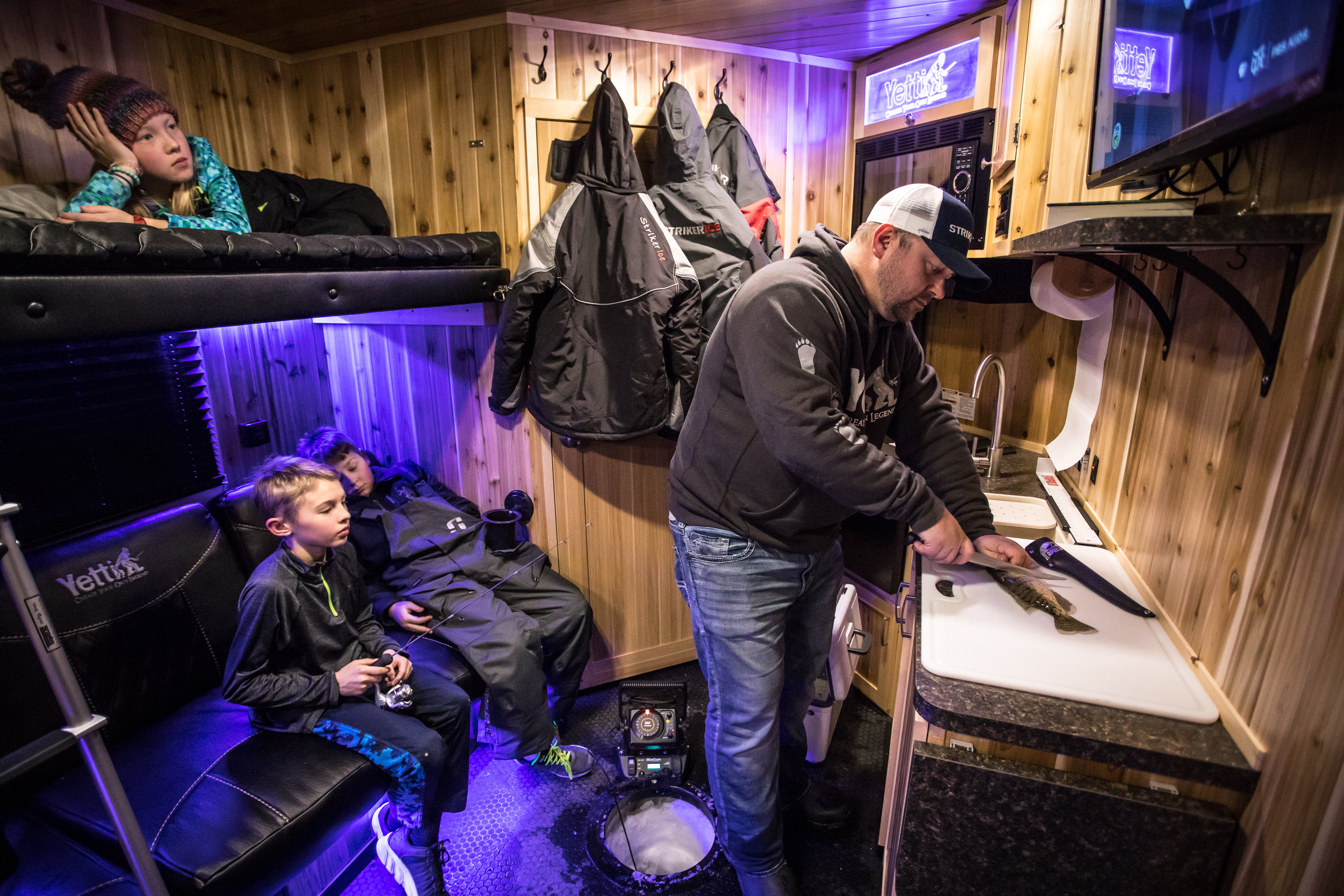Some of the best meals you’ll ever have are eaten outdoors. In the thick of it, while back-country camping or cooking shore lunch on a rocky Canadian Shield lake. Everything tastes better when you’ve hand-crafted it, worked for it. Winter’s version of that in the North Country is a meal made on the ice, and with the advances in wheelhouses these days, our options are getting a whole lot better than just burnt wienies on an inverted sunflower heater.
These days, more and more anglers have access to electric power on ice, a key cooking aid which removes some of the primal appeal, but makes up for it in opportunities to eat well. Microwaves, refrigerators, and a myriad of appliances like crockpots, toaster ovens, and even blenders can make any ice house like your very own home kitchen. Many wheelhouses already come with an oven, and frozen pizzas from them can certainly hit the spot. Even when the crust is borderline burnt and the top is barely thawed, something warm to eat is always welcome. That said, with a small bit of planning, we can do a whole lot better, for less money and effort than you’d expect.
Stock the Kitchen
First things first, you need to have some tools at your disposal, and on-hand staples are a necessity here just like at home. Start with some basic cookware; hand-me-down skillets, a camping pot/lid, along with some measuring cups (dry and liquid) and silverware are a good start. Ziploc bags, some paper plates, cups, and mugs are going to be needed too. You’ll need knives to clean fish, cutting boards to fillet them on, and even some oddballs like can openers, kitchen towels, and hot pads. The venerable crockpot is a great addition, but you can use the one from home in this application. Then focus on some ingredients, mostly in the form of seasonings and spices, with most of the rest of the parts to any meal being something you’ll plan for on an individual basis.
Cooking Fish
Put your fish-cooking gear together in a kit, as pots, stands, and the rest of the equipment is something you’ll likely be hauling into and out-of the fish house, rather than keeping as resident items. I’ve cooked fish both inside and outside, and truly prefer doing the job on the open ice. Some people complain of the smell of oil and fish, but the biggest issue I have is hot oil in an active environment. Rattle reels go off, kids run to the bathroom, and the general chaos of a busy fish-house can make the scalding oil a scary proposition. You’ll also make whatever mess there is from breading and crackling oil outside rather than in. None of which sounds like great fun in high winds and cold temperatures on a pitch-black evening, but I’ve found it to be a small price to pay for a better and safer situation. The key to frying quality fish is hot oil, so I prefer a cast-iron dutch oven to fry out of because it retains heat well, and make sure to use a thermometer for the oil and crank the propane just before you drop the fish in.
Oven Meals
For anyone who’s used a camper oven, you know that the heat comes from the bottom, in force. Many a burnt pizza has been served from these types of ovens, and really the only solution I’ve found is severalfold. First, find a rectangular pizza stone or similar buffer to put directly on the bottom rack. Next, cook any items destined for the rack on a wire rack over a pan. While this seems like a hassle, it’ll keep everything you put in one of these from burning on the bottom. You’ll still get the crispiness and flavor, without the scorched flavor and overdone-ness.
Getting Creative
I’ve had some really great meals in fish-houses over the years, and among them have certainly been a good number of soups and stews. Many of these can be made ahead and refrigerated or frozen, then simply dumped into a crockpot for warming. A good many more have been homemade concoctions in the oven, steaks on an open grill outside, and especially morning diner-style breakfasts. Coolers can be a great asset, especially inside your vehicle as they’ll keep items cold quite often without allowing them to fully freeze, so use that in your repertoire as needed.
The best meal I’ve had on ice? Well it would have to be the Kaiser’s ribs. As in Kaiser Wilhelm II, German Emperor and King of Prussia. Billy Lindner, famed photographer and Fishing Hall of Fame Member is a descendant of the personal chef to the Kaiser, and last winter he made his ancestor’s recipe for us on a filming and photo shoot. Pork ribs, stewed in a rich and fragrant mixture of beer, broth, sauerkraut, and root vegetables were more than we could ever hope for after a long day’s work.
Well, that’s about all I can remember (or disclose) about the Kaiser’s ribs, but I can tell you it beat any frozen pizza I’ll ever have by miles. It also serves as proof that with a little bit of preparation and planning, you can eat as well or better in the fish-house than you do at home.

